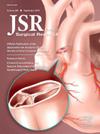Expression and Subtype Discordance Between Core Needle Biopsy and Surgical Specimen in Breast Cancer
IF 1.8
3区 医学
Q2 SURGERY
引用次数: 0
Abstract
Introduction
Estrogen receptors (ERs), progesterone receptors (PRs), and human epidermal growth factor receptors 2 (HER2s) are crucial for the molecular subtype classification and therapy decision-making in breast cancer. Core needle biopsy (CNB) serves as an essential preoperative diagnostic tool for biomarker evaluation, offering minimal invasiveness and convenience. However, CNB has limitations including insufficient sampling volume, sampling errors, underestimation and false results. This study evaluated the discordance of ER, PR, HER2, and molecular subtype between CNB and surgical specimen (SS) in breast cancer, explored the factors associated with discordance and discussed which specific breast cancer cases were recommended for retesting.
Materials and methods
Medical records of invasive breast cancer patients admitted to Fujian Medical University Union Hospital from January 2014 to January 2020 were retrospectively collected. Immunohistochemistry and fluorescence in situ hybridization were used to assess the status of ER, PR, and HER2 in both CNB and SS. The agreement analyses were performed using the Kappa test. Univariable and multivariable logistic regressions were employed to identify factors associated with discordance of biomarkers and molecular subtypes.
Results
A total of 2099 patients were included in the study. Discordance rates were 3.9% (n = 82) for the ER, 4.8% (n = 101) for PR and 1.2% (n = 25) for HER2. High agreement was observed between CNB and SS for ER (κ=0.899), PR (κ=0.896) and HER2 (κ=0.972). There were 344 cases of molecular typing discordance, with the majority (n = 226, 65.7%) occurring between Luminal A and Luminal B (HER2-). Factors of ER discordance were large tumor size (OR = 8.715, P < 0.001), ER-low biopsy status (OR = 49.959, P < 0.001) and PR-high biopsy status (OR = 0.046, P < 0.001. Factors of molecular subtype discordance were carcinoma in situ (OR = 1.930, P = 0.007), ER-low biopsy status (OR = 40.527, P < 0.001) and Ki67-high biopsy status (OR = 0.332, P < 0.001).
Conclusions
CNB showed good accuracy in evaluating ER, PR, HER2, and molecular subtypes in breast cancer. However, concerning the factors associated with discordance, we recommend retesting for three CNB cases (1) ER-negative and PR-positive, (2) ER low-expression and PR-negative, and (3) Luminal A subtype with tumors ≤2 cm, which might offer a valuable reference for clinical decision-making.
求助全文
约1分钟内获得全文
求助全文
来源期刊
CiteScore
3.90
自引率
4.50%
发文量
627
审稿时长
138 days
期刊介绍:
The Journal of Surgical Research: Clinical and Laboratory Investigation publishes original articles concerned with clinical and laboratory investigations relevant to surgical practice and teaching. The journal emphasizes reports of clinical investigations or fundamental research bearing directly on surgical management that will be of general interest to a broad range of surgeons and surgical researchers. The articles presented need not have been the products of surgeons or of surgical laboratories.
The Journal of Surgical Research also features review articles and special articles relating to educational, research, or social issues of interest to the academic surgical community.

 求助内容:
求助内容: 应助结果提醒方式:
应助结果提醒方式:


